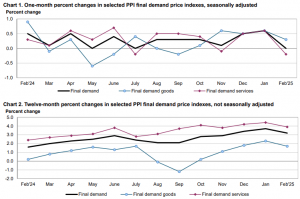May 15, 2025
The Producer Price Index (PPI) for final demand in the U.S. fell 0.5 percent in April on a seasonally adjusted basis, according to the U.S. Bureau of Labor Statistics. Final demand prices were unchanged in March and increased 0.2 percent in February. Over the 12 months ended April 2025, the index for final demand increased by 2.4 percent on an unadjusted basis.
In April, the decline in the index for final demand was driven entirely by a 0.7 percent drop in prices for final demand services, while prices for final demand goods remained unchanged.
Excluding foods, energy, and trade services, the index for final demand edged down by 0.1 percent in April, marking the first decline since April 2020. Over the past 12 months, this index has advanced by 2.9 percent.
Final demand goods
In April, the index for final demand goods was unchanged, following a 0.9 percent decrease in March. Prices for final demand goods excluding foods and energy rose by 0.4 percent. However, prices for final demand foods and energy declined by 1.0 percent and 0.4 percent, respectively.
A key contributor to the unchanged reading was a 1.1 percent increase in prices for general purpose machinery and equipment. Other increases were seen in residential electric power, fresh and dry vegetables, non-electronic cigarettes, and utility natural gas. These gains were offset by a sharp 39.4 percent drop in the index for chicken eggs, along with declines in prices for gasoline, gas fuels, diesel fuel, and primary basic organic chemicals.
Final demand services
In April, the index for final demand services fell by 0.7 percent, the largest monthly decline since the series began in December 2009. This was largely due to a 1.6 percent drop in margins for final demand trade services. Prices for final demand services excluding trade, transportation, and warehousing fell by 0.3 percent, while the index for transportation and warehousing services declined by 0.4 percent.
A significant portion of the decline was driven by a 6.1 percent drop in margins for machinery and vehicle wholesaling. Other notable decreases were seen in portfolio management, food and alcohol wholesaling, system software publishing, traveler accommodation services, and airline passenger services. In contrast, prices for outpatient care rose by 0.3 percent, and the indexes for furniture retailing and inpatient care also increased.

Disclaimer:
Analyst Certification – The views expressed in this research report accurately reflect the personal views of Mayberry Investments Limited Research Department about those issuer (s) or securities as at the date of this report. Each research analyst (s) also certify that no part of their compensation was, is, or will be, directly or indirectly, related to the specific recommendation(s) or view (s) expressed by that research analyst in this research report.
Company Disclosure – The information contained herein has been obtained from sources believed to be reliable, however its accuracy and completeness cannot be guaranteed. You are hereby notified that any disclosure, copying, distribution or taking any action in reliance on the contents of this information is strictly prohibited and may be unlawful. Mayberry may effect transactions or have positions in securities mentioned herein. In addition, employees of Mayberry may have positions and effect transactions in the securities mentioned herein.







